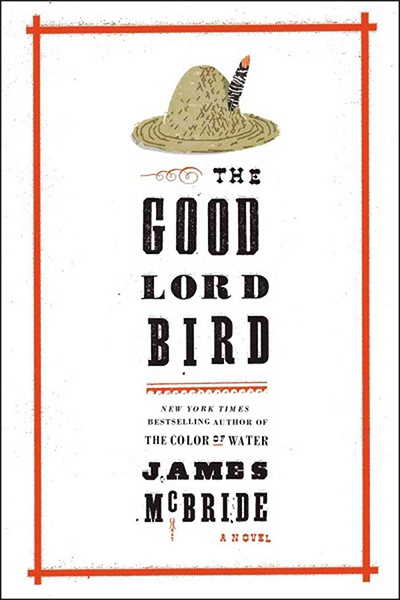Books
The Good Lord Bird
The Good Lord Bird
From the bestselling author of The Color of Water and Song Yet Sung comes the story of a young boy born a slave who joins John Brown’s antislavery crusade—and who must pass as a girl to survive.
Henry Shackleford is a young slave living in the Kansas Territory in 1857, when the region is a battleground between anti- and pro-slavery forces. When John Brown, the legendary abolitionist, arrives in the area, an argument between Brown and Henry’s master quickly turns violent. Henry is forced to leave town—with Brown, who believes he’s a girl. Over the ensuing months, Henry—whom Brown nicknames Little Onion—conceals his true identity as he struggles to stay alive. Eventually Little Onion finds himself with Brown at the historic raid on Harpers Ferry in 1859—one of the great catalysts for the Civil War. An absorbing mixture of history and imagination, and told with McBride’s meticulous eye for detail and character, The Good Lord Bird is both a rousing adventure and a moving exploration of identity and survival.
— New York Times Review: By The Book
http://www.nytimes.com/2013/08/04/books/review/james-mcbride-by-the-book.html
Reviews
Musician and author McBride offers a fresh perspective on abolitionist firebrand John Brown in this novel disguised as the memoir of a slave boy who pretends to be a girl in order to escape pre–Civil War turmoil, only to find himself riding with John Brown’s retinue of rabble-rousers from Bloody Kansas to Harpers Ferry. “I was born a colored man and don’t you forget it,” reminisces Henry Shackleford in a manuscript discovered after a church fire in the 1960s. Speaking in his own savvy yet naïve voice, Henry recounts how, at age 10, his curly hair, soft features, and potato-sack dress cause him to be mistaken for a girl—a mistake he embraces for safety’s sake, even as he is reluctantly swept up by Brown’s violent, chaotic, determined, frustrated, and frustrating efforts to oppose slavery. A mix-up over the meaning of the word “trim” temporarily lands Henry/Henrietta in a brothel before he rejoins Brown and sons, who call him “Onion,” their good-luck charm. Onion eventually meets Frederick Douglass, a great man but a flawed human being, Harriet Tubman, silent, terrible, and strong. Even more memorable is the slave girl Sibonia, who courageously dies for freedom. At Harpers Ferry, Onion is given the futile task of rousting up slaves (“hiving bees”) to participate in the great armed insurrection that Brown envisions but never sees. Outrageously funny, sad, and consistently unflattering, McBride puts a human face on a nation at its most divided.
In McBride’s version of events, John Brown’s body doesn’t lie a-mouldering in the grave–he’s alive and vigorous and fanatical and doomed, so one could say his soul does indeed go marching on. The unlikely narrator of the events leading up to Brown’s quixotic raid at Harper’s Ferry is Henry Shackleford, aka Little Onion, whose father is killed when Brown comes in to liberate some slaves. Brown whisks the 12-year-old away thinking he’s a girl, and Onion keeps up the disguise for the next few years. This fluidity of gender identity allows Onion a certain leeway in his life, for example, he gets taken in by Pie, a beautiful prostitute, where he witnesses some activity almost more unseemly than a 12-year-old can stand. The interlude with Pie occurs during a two-year period where Brown disappears from Onion’s life, but they’re reunited a few months before the debacle at Harper’s Ferry. In that time, Brown visits Frederick Douglass, and, in the most implausible scene in the novel, Douglass gets tight and chases after the nubile Onion. The stakes are raised as Brown approaches October 1859, for even Onion recognizes the futility of the raid, where Brown expects hundreds of slaves to rise in revolt and gets only a handful. Onion notes that Brown’s fanaticism increasingly approaches “lunacy” as the time for the raid gets closer, and Brown never loses that obsessive glint in his eye that tells him he’s doing the Lord’s work. At the end, Onion reasserts his identity as a male and escapes just before Brown’s execution. McBride presents an interesting experiment in point of view here, as all of Brown’s activities are filtered through the eyes of a young adolescent who wavers between innocence and cynicism.
You may know the story of John Brown’s unsuccessful raid on Harpers Ferry, but author James McBride’s retelling of the events leading up to it is so imaginative, you’ll race to the finish. The tale is told by a young slave from the Kansas Territory, Henry Shackleford, who’s around 12 when he’s freed by Brown and mistaken for a girl. It’s an error that goes uncorrected, and Henry, dubbed “little Onion” by his new companion, finds the disguise useful as he travels with Brown and his men. Onion meets more than one historical character on his journey — there’s even an outlandish vignette starring a drunken Frederick Douglass. But through Onion’s eyes, it’s the famed abolitionist he calls “Old Man” who really comes alive — radical and obsessive, and ultimately doomed.
“McBride continues exploring the long history of America’s color line, begun in his landmark memoir, The Color of Water. A young slave in the Kansas Territory, Henry Shackleford must flee with abolitionist John Brown after Brown clashes with Henry’s master. Complicating matters: Brown thinks Henry is a girl, a disguise Henry maintains up to the bold raid on Harpers Ferry.”
Assistant
Margaret S Saunders
maggiesaunders820@gmail.com
Publicity To Book
Ashley Garland
AGarland@penguinrandomhouse.com
To write to James McBride
James McBride
JamesMcBride@jamesmcbride.com

